Condition problems
"Reality check on aisle one! Reality check, please."
The hobby of scripophily is all about collecting securities. In order to qualify as a security, a document must have represented value at one time, either as partial ownership in a company or as a loan made to a company. Documents that could have been converted to ownership or debt also qualify, as do documents that represented ownership in property used directly by companies. In short, securities constituted several kinds of paper documents that we call stocks, bonds, temporary stocks and bonds, options, and equipment trusts. A number of closely related documents are also collected along with stocks and bonds because they played important roles in the sale, transference, and usage of ordinary securities.
Strictly speaking, unissued stocks, bonds, et cetera were never securities. They are called remainders and are merely printed pieces of paper. Remainders are documents that could have become securities, had they been used. Nonetheless, they are collected along with previously-valid securities, although priced considerably lower.
Experienced collectors also buy specimens and proofs, usually at the same or higher prices than issued certificates.
In our hobby, as in all other collectible hobbies that I have encountered, condition is one of the three most important determinants of price. Obviously, price is determined by desire, condition, and rarity, all of which vary constantly. Condition is the only one that can be seen, felt and even smelled. Since collectors are primarily collecting issued stocks and bonds, understanding the major types of condition problems to look out for is paramount.
Collectible certificates exist in four states of issuance
Issued certificates are normal certificates that were used for their intended purposes. Different certificate types took different paths and show greater and lesser degrees of circulation depending on their original purposes. Subscription receipts encountered different fates than stocks and bonds, but all were intended to pass from one hand to another. Each transfer offered its own hazards, all of which created the paper conditions we see today.
Here is an example of the journeys collectible certificates often took.
Proofs
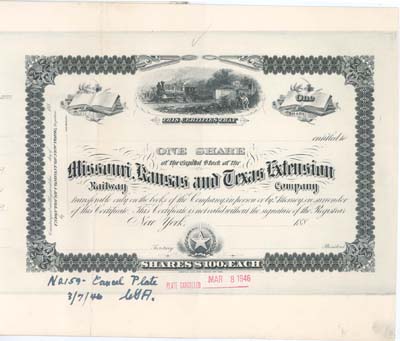
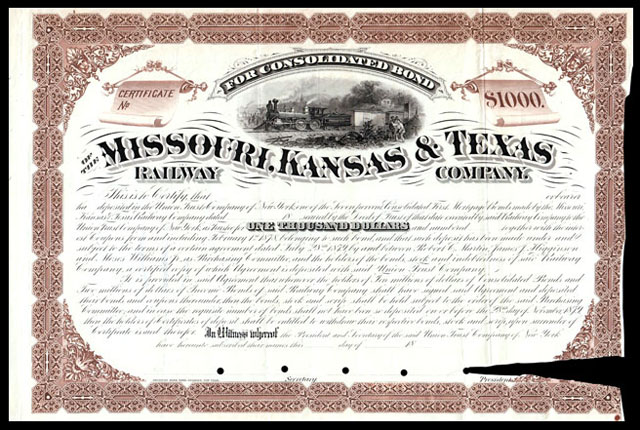
Proofs are examples of documents produced by engravers during the process of designing new certificates or updating old ones. The overwhelming majority of proofs were temporary working documents that were discarded almost as quickly as they were created. Still, a precious few were retained by printing and engraving companies.
Markings on some proofs show they were examples sent to clients for approval and retained by companies as evidence of acceptance. Some show somewhat of a bookkeeping purpose in that they recorded production plate numbers and records of final plate destruction after certificates were retired. In general, proofs were file copies retained for potential future purposes. Most proofs show markings by pen, pencil, and crayon. While sometimes important from historical corporate perspectives, handwritten notes on proofs are usually mundane.
Proofs played no official role other than as a repository for handwritten notes. Very few proofs exist in pristine form. Proofs were rarely protected from damage. Careful handling was usually ignored. Proofs were often printed on thick paper or card stock and many suffered severe abuses of folding, tearing, foxing, and general paper destruction. Almost all are uniface documents.
While engravers may have "pulled" proofs in several different colors or tested minor engraving variations, essentially all proofs are unique. The Missouri Kansas & Texas Railway Company proof at right is not particularly unusual. This one was printed on thin India paper and shows a piece missing from the right margin. I would be confident in guessing the damage was caused by a stapled note or invoice getting caught on something during removal from a file drawer. It is not a show piece, BUT let's remember it is probably unique.
Specimens
Unlike proofs, specimens were stored in near-pristine condition, although many encountered rough handling at times thereafter. Specimens exist as documentary evidence of final production of certificates prior to delivery to companies. Specimens were one- or two sided, identical to fully-issued certificates. If representing bearer bonds, they have coupons attached. Most, but not all, specimens can be differentiated from regular-issuance certificates only by:
- serial numbering with zeros (e.g. #0000, #00000, etc.)
- pairs of two tiny punch holes in signature areas
Some engraving companies, American Bank Note Company premier among them, retained a few specimens for their own files. While many specimens are unique, some may be represented by ten or more examples. Since they are commonly identical, there is apparent no way to track specimen populations. American Bank Note Company and a few other printers provided one or more specimens to corporations for their files.
When companies did not receive (or did not order) specimens from their printers, they occasionally made their own. Some companies marked remainders with the word "Specimen," while a few re-purposed issued stock certificates that had been returned for transference of shares to other investors.
Although specimens never traveled the paths of issuance and transferal, they often suffered deterioration or damage during storage. Specimens often show bent corners, corner tip folds, and edge wrinkling sustained during inevitable examination, movement and re-filing. Many specimens freed from American Bank Note Company archives in the early 2000s show rubber-stamped notices that specimens were to be returned to the "Specimen Department."
Issued certificates
Printers usually delivered stock certificates to companies in bound "stock books" of 50 to 200 pages. Stock books were usually maintained by companies treasurers who passed them to clerks who hand-wrote stockholders' names, dates, and shares on certificates and their attached stubs. They then cut or tore certificates from stock books and passed them to corporate officers. Some officers signed in advance of preparation, but most seem to have added their signatures to stock certificates after completion. Based on surviving certificates that were stopped midway through the process, it appears presidents usually signed certificates before treasurers. Treasurers then signed certificates and finalized sales by impressing corporate seals with crimping devices. In later years, certificates then passed to trust companies and/or registrars whose clerks added their own dates and signatures.
Once certificates had been officially issued, they were usually shipped to brokers and then perhaps to owners. Depending on who actually held the stocks, certificates were often folded in thirds and hidden away in desks, safes, deposit boxes, and vaults. Storage may have lasted days or years and it could have been careful or shoddy. The longer the storage times, the more wear and tear certificates normally suffered.
Once owners decided to sell, certificates started their journey back to company clerks. Owners normally alerted brokers of their intent to sell, at which point brokers negotiated with willing buyers. Once purchase prices were agreed upon, owners signed the backs of certificates, often along with witnesses who attested to their legal ownership. From that point, certificates passed through the hands of intermediaries (banks, brokers, trust companies) who each may have added their own signatures and transfer marks. Once certificates arrived back at corporate headquarters, clerks cancelled old certificates, in a multitude of ways, and added dates and notations of their own, In the early days, certificates were glued back to their original stubs in stock books. Finally, companies stored certificates for later bookkeeping purposes.
Bonds represented debts that companies owed and were handled differently. In major companies, entire issuances of bonds, sometimes numbering into several tens of thousands, were sold to investment banks or groups of wealthy investors at significant discounts. Those banks or investors then re-sold some of all to private investors or smaller banking and lending concerns.
Whoever ended up with bonds exercised their own storage routines, usually storing in safes of some kind. If they were coupon bonds, as most were prior to the 1880s, investors retrieved them twice a year to clip coupons. Like stock certificates, the longer the storage time, the more evidence of usage appears. Unlike bonds, most were never returned to companies until replaced by later issuance. Railroad bankrupted with alarming frequency, so bonds were often collected by "bondholder committees" who managed resale of company assets and recovery of as much funds as possible. At that point, bonds were frequently stamped with amounts of returned principal, and perhaps ultimately cancelled.
It appears companies usually preserved old certificates as long as corporations existed, although some documents no doubt suffered accidental damage or destruction through accidents, mishandling, fire, floods, and earthquakes. A large, unknown percentage of certificates were purposely incinerated whenever companies dissolved. Theoretically, only small percentages of issued stocks and bonds survive for today's collectors.
Remainders (aka unissued certificates)
Not every company was able to attract investors and so large numbers of unissued certificates exist from companies that failed. Many companies merged with more successful companies and again left partially used books or collections of certificates. When two or more companies consolidated and created new companies, the number of unused certificates doubled or tripled. Among small and unsuccessful companies, the numbers of unused remainders significantly exceeds those that had been legitimately issued and traded.
Some remainders were prematurely signed and later cancelled. We cannot know for sure, but it appears most companies destroyed their unused certificates. The unissued "remainders" that remain today commonly represent certificates in the best conditions. Nonetheless, collectors generally discount unissued certificates relative to issued certificates regardless of condition.
Typical problems
Even among unissued remainders, condition problems are normal and expected. The vast majority of issued certificates have some kind of flaw that a sharp-eyed collector could spot. Having said that, I don't remember encountering an experienced scripophily collector who was overly picky about condition. As a group, I have found collectors in our hobby to be highly forgiving of problems. They understand that all our previously-valid securities passed through the hands of many people. A perfect issued certificate is almost a misnomer. When it comes to adding certificates to a collection, price becomes a measurement of desire that takes into account all of the possible variables of collecting, condition being merely one.
Here are most of the most problems collectors will encounter.
Rips, tears and missing pieces
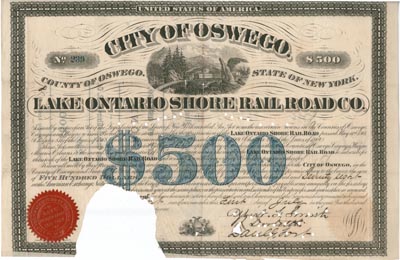
Paper weakens every time it is folded and unfolded. The more often a certificate endures the folding-unfolding cycle, the more likely it is to develop tears.
Equally obvious, the lower the quality of paper used, the more easily it will tear. American Bank Note Company generally used very high quality paper, especially for most of its bonds. Some paper used for bonds is thick, fibrous, and hard to tear. At the other end of the quality spectrum are certificates created by local stationery and newspaper printers. For them, security printing was a side business and they were unconcerned with the longevity of their printed documents. It is therefore common to see more tears and rips among some of the rarest certificates of small, short-lived companies. Those kinds of companies could seldom afford good printing.
Small edge tears are common, especially on lower quality generic certificates. Ratty edges will lower prices, of course, but edge tears are usually tolerated. Missing pieces quite obviously lower prices substantially. Nonetheless, there are a few ultra-rare items that are known only as partial certificates with half or more missing. Prices for those, like most other rarities, are penalized drastically, but still sell for whatever the market will bear.
Over-zealous cancellations
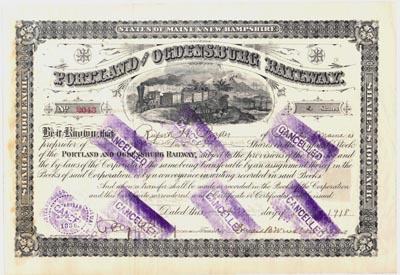
Cancellations were customary and necessary when companies redeemed or reissued certificates. The types and degrees of cancellation are monumentally variable. It is extremely common to see two, sometimes as many as five, different methods of cancellation on a single certificate. A few clerks, however, were curiously zealous in cancelling certificates, some to the point of near-obliteration.
As a general rule, premiums paid for uncancelled certificates range anywhere from 20% to 100%. Of course, people of all levels of experience sell on eBay, so it is not unusual to encounter inverted prices from time to time.
Few collectors specialize in uncancelled certificates to the exclusion of others, so cancellations are usually considered average and ordinary to the hobby. The only times cancellations become problems is when they are excessive, obtrusive or impinge upon vignettes. While collectors might tolerate such problem in the quest for completeness in some area of specialization, they should consider that there will be a time in the future when selling will become an issue. How will future buyer tolerate excessive cancellations? Certificate prices are so variable that it is hard to detect the extent of price penalties for too much cancellation, but I suspect they exist.
Missing coupons
Coupons were attached to most early bonds. Companies usually required owners to cut coupons from bonds every six months and return them for interest. It is uncommon to find Issued coupon bonds with all coupons attached. Coupon bonds from successful companies often have all their coupons removed. The degree of coupon preservation or removal usually has little measurable or predictable effect on prices.
Show-through
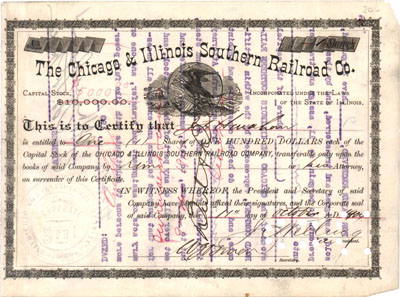
The concept of transferring a stock certificate is identical to the process of cashing a check. A person who will receive money (the payee) legally confers title to the asset (the check) by signing on the back. It is the same with stock certificates. Consequently, most stock certificates that were sold and transferred display handwriting on the back. If a stockholder was particularly heavy-handed with a fountain or quill pen, excess ink soaked through certificates and showed through to the front. Some show-through is normal. Prices are adversely affected when cancellation becomes excessive.
In a few rare cases usually involving insolvency, court actions caused further markings. Such marking are usually found on the front of certificates, but occasionally on the back when more space was needed. Again, the extent of show-through negatively affects price.
Stubs
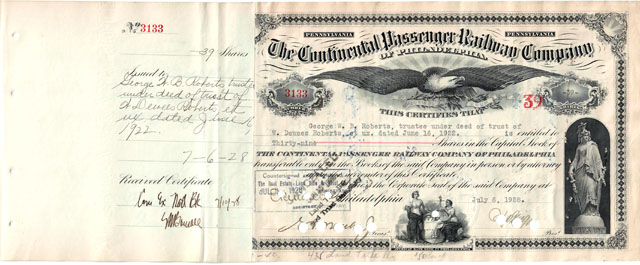
Clerks often glued stock certificates back to their original stubs when they were returned to companies for cancellation and replacement. As dealers and collectors broke up old stock books to sell single certificates, they often left stubs or parts of stubs attached.
Some collectors, myself included, do not like stubs because they hide parts of certificates. Others think they more accurately represent original conditions. Glued stubs are normal, but their existence or absence does not seem to affect prices predictably.
Ink blotches
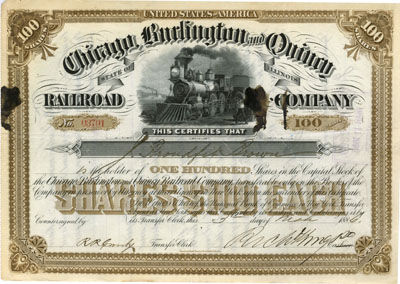
Drops of fountain pen ink, often drug sideways by a hand, are encountered occasionally. Most certificates were quickly voided if ink accidents occurred during issuance. I suspect the two large ink blotches on this Chicago Burlington & Quincy Railroad stock certificate were created during the transfer from one owner to another. Sellers don't always describe these kinds of problems, but I suggest buying better certificates if possible.
Missing corner tips
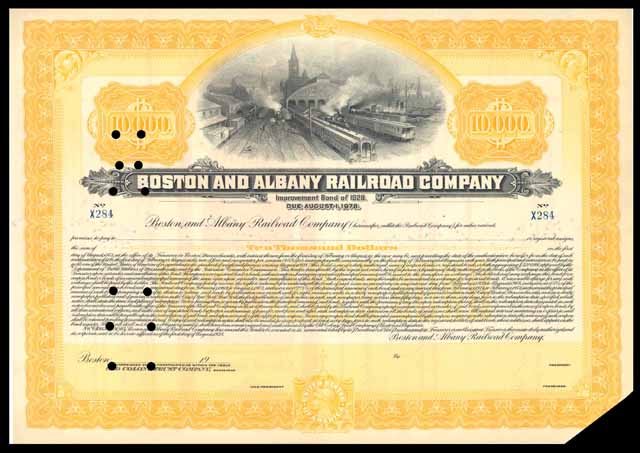
Certificates usually sustained abuse during their life cycles so it is almost impossible for corner tips to remain entirely undamaged. Amazingly, missing corner tips are abnormal. They do adversely affect price when obvious.
Foxing
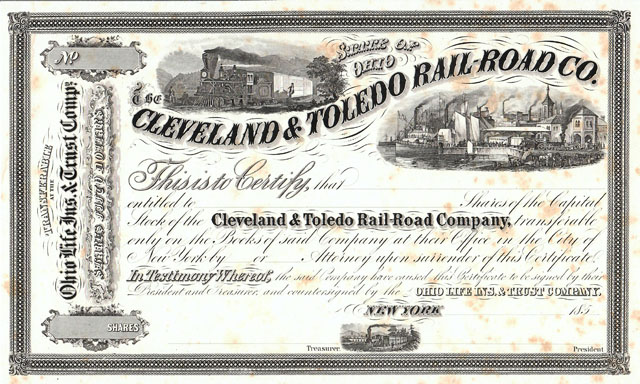
Foxing is a condition common to documents stored in humid atmospheres, although the causation is not well understood. Foxing is a collection of light brown spots somewhat resembles a rusty-looking rash. Instead of sitting on top of the paper, foxing is really within the paper fibers. Foxing is evident on this uniface proof of the Cleveland & Toledo Rail-Road Company. It was printed on soft, thick paper and foxing is visible on the right side and is even more noticeable on the back. I would suggest discounting for foxing. Foxing is not unusual on proofs, but is very rarely seen on regular certificates and specimens.
Ink burn
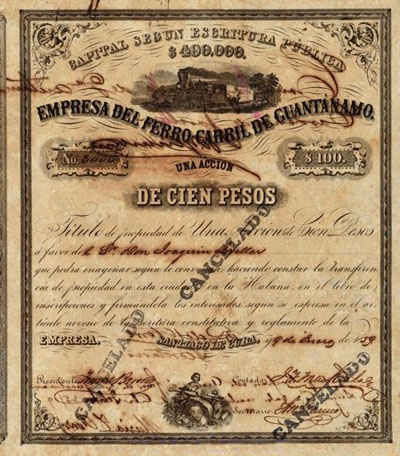
Old fountain pen and quill ink was usually composed of lamp black, linseed oil and other additives to help it flow more easily. Some of the components of old ink were slightly acidic and "ate through" or "burned" certificates over time. Minor acidic ink deterioration is not uncommon and appears as brown halos around pen strokes. Advanced ink deterioration is often discounted heavily. Like other problems, the more apparent the deterioration, the lower the price.
(Almost all certificates from this Cuban company show ink halos and ink burns.)
Handwriting
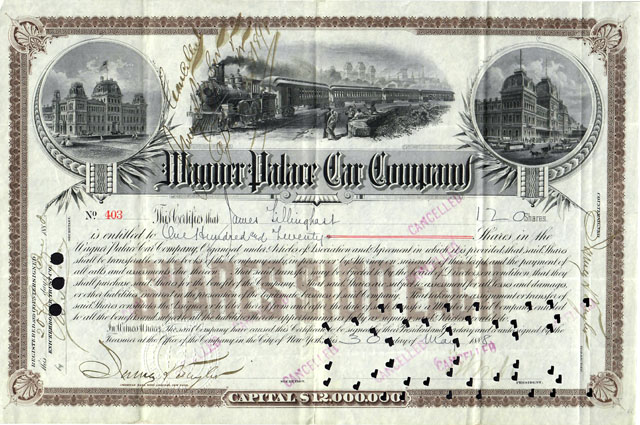
Many certificates, from very old to recent, show handwritten notations. Writing can range from simple checkmarks to elaborate records of transfer or probate proceedings. Notations can appear on the fronts or the backs of certificates, although those on the backs tend to be more verbose. Excessive marking should be described when selling, although handwriting does not always lower prices. A few collectors might even pay slight premiums for certificates with elaborate stories.
The vignette on this Wagner Palace Car stock certificate is always impressive, but this one was over-written by ink pen during cancellation. I suggest lowering bids on these kinds of problems 25% to 50%.
Paper deterioration
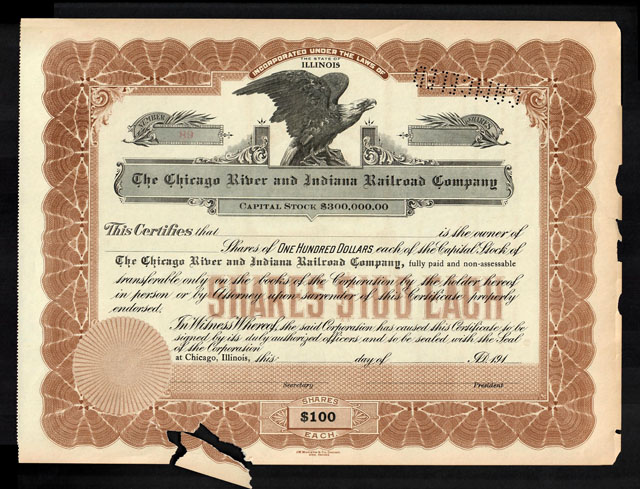
Paper composed of cotton fibers (rag paper) is usually not acidic Rag paper tends to stay supple for very long periods.
The paper-making process that allows wood fibers to be used for papermaking almost always leaves trace amounts of acid in paper. Over time, that tiny bit of acid discolors paper and makes it very brittle. Exposure to sunlight hastens acidic deterioration significantly. Certificates in such condition sell for much, much less. That does not mean sellers always report pulp paper deterioration. Watch out for certificates that look brown in images. Don't be afraid to ask sellers to explain. Collectors may not be able to avoid acid deterioration entirely because generic certificates were often printed on wood pulp paper.
At right is a certificate from the Chicago River & Indiana Railroad Company. It is on the verge total destruction and would fall to pieces if handled more then a few times. This certificate is probably not worth keeping except no others have ever been reported.
Water damage
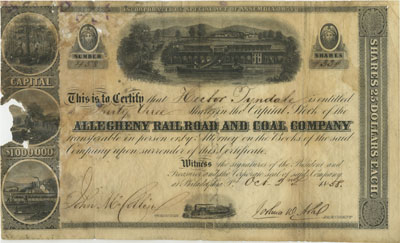
A small percentage of certificates show water spots from unknown situations. Entire varieties of some certificates show wrinkled paper and water stains throughout, suggesting whole stacks of certificates sustained damage during storage. Paper wrinkling can sometimes be removed, but only at the risk of further deterioration. In general, water stains and wrinkling lower prices..
Rodent and insect damage

It is common to encounter rodent damage on old newspapers and magazines. Such damage is rarely seen on certificates. The water-damaged certificate above appears to have rodent damage along the left edge. Rodent damage can be identified by series of semi-circular "nibbles" out of edges, usually three to four millimeters in diameter. I advise avoiding rodent damage if at all possible. Flyspecks (fly excrement) are also rare. Flyspecks are often removable with a lightly-dampened tissue.
Uneven borders and bad trim
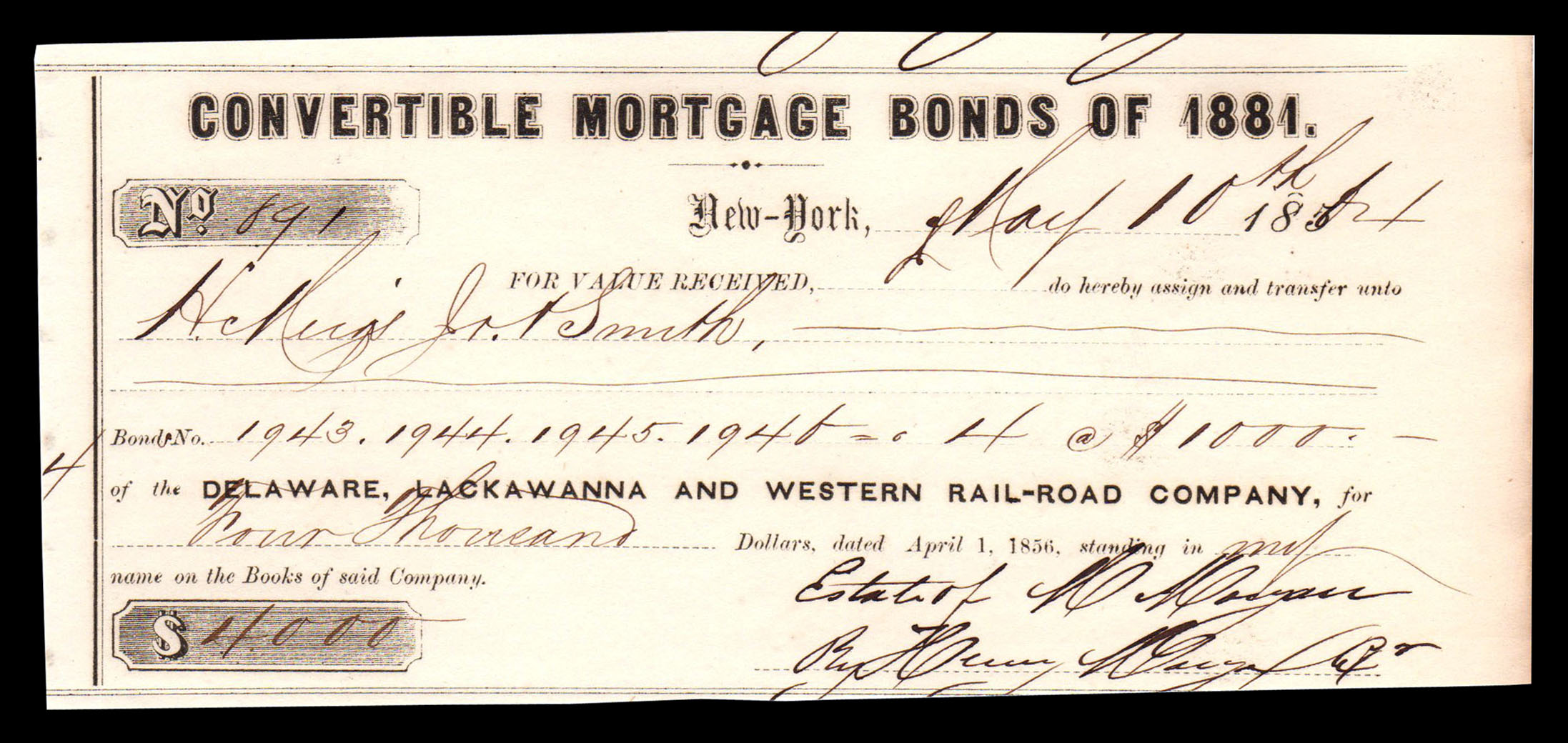
The earliest certificates were trimmed and cut apart with scissors, so the older the certificate, the more likely that edges will be uneven. Maintaining even edges never seemed to have been terribly important until American Bank Note Company came along and raised the bar of professionalism.
I have found that most collectors want certificates with margins around all edges. In practice, it is hard to find some certificates with full margins. This is especially true with early certificates that were frequently printed with almost no margins at all. There are most assuredly price penalties when edges cut into designs, but the older the certificate, the less pronounced the price penalty.
Some of the worst trims are encountered with average working documents such as assessment receipts and transfer receipts. Shown is a poorly-trimmed transfer receipt from the Delaware Lackawanna & Western Railroad Co.
Dirt

I see the most dirt on certificates held over long periods. Some are outright filthy. On balance, however, heavy soiling is rather uncommon. Again, I suggest choosing cleaner certificates if collectors encounter one like shown at right.
Poor placement of stamps and other post-issuance modifications
Anything placed over vignettes and other important features will decrease prices paid for certificates. These can include revenue stamps, pen markings, and cancellations. I have even seen adhesive stickers placed over vignettes to inform stock holders or clearing house employees of corporate name changes.
Staple holes and pin holes
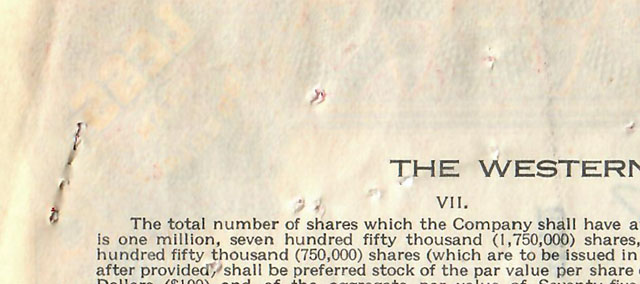
Staplers did not become an office standard until the 1870s, so staple holes are rarely problems on certificates issued before that. Staple holes are a distraction and collectors discount for them to some degree. For the most part, though, collectors ignore staple holes unless they seriously harm the appearance of certificates. The example at right shows several staples had been removed from this 1945 certificate. Even then, the holes are more visible from the back than the front.
The bigger problem are certificates with staples still in place. Most of the certificates I have encountered have had staples removed and I have removed many myself. Leaving staples in place creates several potential problems, the worst being rust stains appearing on certificates stored in humid environments. Another problem is potential damage to surrounding certificates.
Cigarette smoke
Do not be surprised if you smell cigar or cigarette smoke when you open packages from eBay sellers. Odor is an invisible problem and is one that goes unnoticed by sellers who are smokers. I do not know of any way it can impact purchase price except with in-person purchases. It is a definite annoyance to non-smokers. The odor will dissipate if certificates are placed in a cool garage or well-ventilated storage area away from the sun for a week or so.
Bubble wrap dents
Some eBay sellers ship certificates in bubble wrap envelopes. This is really bad because the bubbles in those envelopes are crushed into surrounding mail during transit and they dent the softer paper of certificates. I have had a couple of rarities damaged in this way. I strongly advise ALL collectors to contact eBay sellers immediately upon purchase and demand they NOT ship certificates in bubble wrap or bubble wrap envelopes. Like water-wrinkled paper, prices will always be adversely affected forever into the future. I have never perceived such problem with items received from professional dealers.
Plasticizer "grease" from old vinyl holders
I have not encountered this NASTY problem in recent years, but I encountered it frequently in the mid-1980s when dealing with paper money. Plasticizers are chemicals that make vinyl softer and more supple. Unfortunately, as vinyl ages, plasticizer migrates to whatever is nearby. It feels like a thin grease and makes paper look semi-transparent. As with several other one-way problems, avoidance is almost always better than price negotiation.
Some people claim they can remove plasticizer damage, but I cannot confirm.